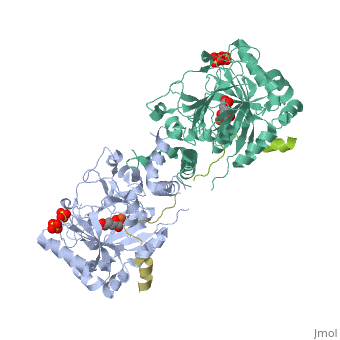Molecular Playground/FIH
From Proteopedia
| Line 4: | Line 4: | ||
'''H'''ypoxia '''I'''nducible '''F'''actor (HIF)is a heterodimeric transcription factor that regulates over 100 genes. <scene name='40/400574/Hif/3'>HIF</scene> consists of a constitutively expressed beta subunit, and an alpha subunit that is regulated in oxygen dependent manner. There are two enzymes that regulate HIF controlled gene expression, '''F'''actor '''I'''nhibiting '''H'''IF (FIH) and '''P'''rolyl '''H'''ydroxylase '''D'''omain 2 (PHD2). Under normoxic conditions, hydroxylation of one or both proline residues in the Oxygen Degradation Domain (ODD) of HIF results in proteosomal degradation of the HIF alpha subunit. Hydroxylation of an asparagine residue | '''H'''ypoxia '''I'''nducible '''F'''actor (HIF)is a heterodimeric transcription factor that regulates over 100 genes. <scene name='40/400574/Hif/3'>HIF</scene> consists of a constitutively expressed beta subunit, and an alpha subunit that is regulated in oxygen dependent manner. There are two enzymes that regulate HIF controlled gene expression, '''F'''actor '''I'''nhibiting '''H'''IF (FIH) and '''P'''rolyl '''H'''ydroxylase '''D'''omain 2 (PHD2). Under normoxic conditions, hydroxylation of one or both proline residues in the Oxygen Degradation Domain (ODD) of HIF results in proteosomal degradation of the HIF alpha subunit. Hydroxylation of an asparagine residue | ||
| - | (<scene name='40/400574/Asn803/1'>Asn803</scene>) in the C-Terminal Trans-Activation Domain (CTAD) of HIF by FIH results in transcriptional silencing of genes due to HIF's inability to recruit the co-activator p300. However, under hypoxic conditions, there is no hydroxylation, resulting in stabilization of the HIF alpha subunit. The alpha subunit dimerizes with the beta subunit and HIF is able to transcribe genes important for red blood cell production, metabolic activity, angiogenesis,development, and many other functions. | + | (<scene name='40/400574/Asn803/1'>Asn803</scene>) in the C-Terminal Trans-Activation Domain (CTAD) of HIF by FIH results in transcriptional silencing of genes due to HIF's inability to recruit the co-activator p300. However, under hypoxic conditions, there is no hydroxylation, resulting in stabilization of the HIF alpha subunit. The alpha subunit dimerizes with the beta subunit and HIF is able to transcribe genes important for red blood cell production, metabolic activity, angiogenesis,development, and many other functions. |
=== Active Site=== | === Active Site=== | ||
| Line 12: | Line 12: | ||
=== Enzyme Surface === | === Enzyme Surface === | ||
| - | In this depiction, the <scene name='User:John_Hangasky/Sandbox_1/Fih_surface/4'>solvent accessible surface</scene> of FIH is shown. | + | In this depiction, the <scene name='User:John_Hangasky/Sandbox_1/Fih_surface/4'>solvent accessible surface</scene> of FIH is shown. <scene name='40/400574/Conservation/1'>Here</scene> we see that the β-barrel core of the enzyme is highly conserved whereas the α-helices on the surface maintain variability. |
===3D structures of FIH=== | ===3D structures of FIH=== | ||
Revision as of 01:10, 4 December 2013
|
Contents |
Factor Inhibiting HIF
Hypoxia Inducible Factor (HIF)is a heterodimeric transcription factor that regulates over 100 genes. consists of a constitutively expressed beta subunit, and an alpha subunit that is regulated in oxygen dependent manner. There are two enzymes that regulate HIF controlled gene expression, Factor Inhibiting HIF (FIH) and Prolyl Hydroxylase Domain 2 (PHD2). Under normoxic conditions, hydroxylation of one or both proline residues in the Oxygen Degradation Domain (ODD) of HIF results in proteosomal degradation of the HIF alpha subunit. Hydroxylation of an asparagine residue () in the C-Terminal Trans-Activation Domain (CTAD) of HIF by FIH results in transcriptional silencing of genes due to HIF's inability to recruit the co-activator p300. However, under hypoxic conditions, there is no hydroxylation, resulting in stabilization of the HIF alpha subunit. The alpha subunit dimerizes with the beta subunit and HIF is able to transcribe genes important for red blood cell production, metabolic activity, angiogenesis,development, and many other functions.
Active Site
The contains an iron (II) core. The iron core is coordinated by 2 histidine residues, an aspartate residue, an α-ketoglutarate molecule (α-KG), and one water molecule. The iron (II) is six coordinated, with α-KG chelating in a bidentate manner. The coordination of the active site ligands can be seen . The axial coordination position is initially occupied by a water molecule. Upon binding of CTAD, this water molecule is released, opening a coordination site for oxygen to bind.
Enzyme Surface
In this depiction, the of FIH is shown. we see that the β-barrel core of the enzyme is highly conserved whereas the α-helices on the surface maintain variability.
3D structures of FIH
Additional Resources
For additional information, see: Cancer
Proteopedia Page Contributors and Editors (what is this?)
Vanessa Chaplin, John Hangasky, Michal Harel, Cornelius Taabazuing, David Canner, Breanne Holmes UMass-Amherst

